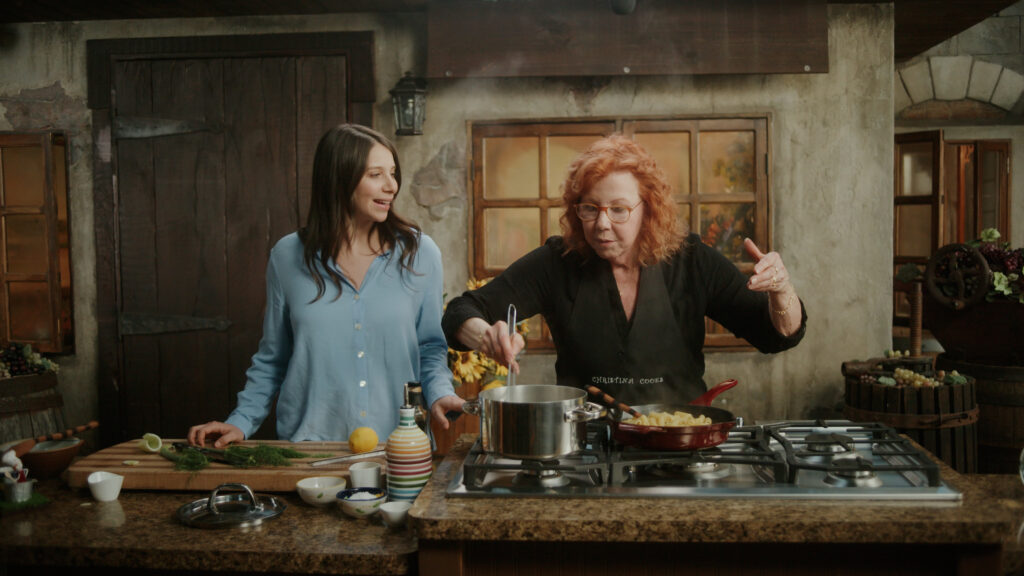Christina Pirello brings a unique blend of Italian culinary roots and Eastern macrobiotic influences to the forefront in each episode of “Christina Cooks”, on KLCS Public Media. Unlike many other TV chefs, she delves into health topics like the microbiome and the intricate balance of the gut’s “flora and fauna,” reminiscent of insightful discussions you’d expect from a health professional. Her journey with leukemia has fueled her passion for advocating the medicinal potential of food, particularly the potency of plants and miso. In her latest episodes, she whisks us away to the heart of Italy, offering a taste of both the cuisine and the culture. Intrigued, we reconnect with Christina to delve into the essence of her new shows, exploring themes of wanderlust, environmental consciousness, and catching up on her latest endeavors since our last conversation. Christina Pirello’s culinary world is not just a feast for the taste buds; it’s a holistic exploration of the intersection of health, culture, and deliciousness.
Christina, since we last spoke, what have you been up to? I wrote another book, VegEdibles. We’ve done three seasons filming in Italy. I think when I talked to you last, I wasn’t filming there yet, I was just taking groups. We just finished our third season, we filmed in Rome and Naples the first season, second season was Tuscany and Umbria, and this last Season we just filmed in Puglia, it was amazing, amazing!
How many trips are you going to this year to Italy?
Robert [her husband and Executive Producer] and I are going in February for the whole month on business and then we have five group trips that are all sold out and a sixth trip that’s half sold out. The sixth is to Rome and the surrounding region in May.
I didn’t think your show could get any better, but it has, in so many ways. I love the episodes we’ve aired recently on Saturdays, where you show clips in Italy talking to folks there and cooking from a house in Tuscany; I feel like I’ve escaped with you to Italy. Have you thought about of doing an entire season from that house and kitchen?
We are, not from that house, but we actually are traveling to Italy again in February, for the month, to do a bunch of research and meetings to do an entire season there. Maybe Sicily, maybe Tuscany, it all depends on the department of agriculture in Tuscany and what they want to do.
Were you in Pompeii for leisure and then did a brief segment there, or did you plan that for the show?
We did plan it for the show because we’ve been to Pompeii so many times with that particular guide and the interesting thing is that every time he takes us to Pompeii, I go with my group every time we do the tour, I always learn something new from him about Pompeii. He’s become, sort of, our food historian behind the scenes and on camera; his name is Antonio Mosca.
I loved that you asked about what they ate and he knew the answer.
They have the whole exhibit in Pompeii showing things like lentils, millet, barley farro, bread and olive oil. It was really interesting to me, so, he always builds on that for me. They certainly ate meat too, but it surprised me how plant-centric their diet was. They really thought that it made them stronger to eat plants more than animals.
Also in those days, meat was mostly a luxury.
It was, even in wealthy households it was not on the table every day, maybe once a week. They really were much more, what we would call, plant-forward.
I love how you always include the health facts, such as miso in soup aids in digestion, or how cooking peppers helps with absorbing it for those who may have arthritis. Could drinking hot tea with dinner be like soup to aid in digestion as well?
It’s not the same, the reason miso soup is so beneficial to digestion is not the soup, as much as it is the miso because of its live bacteria, but hot liquids in general relax the digestive track. What miso brings to the table is an additional boost to digestion and the microbiome of the gut; hot tea will certainly relax the digestive tract, but it won’t nourish your flora and fauna as miso will. Miso’s fermentation is the key.
Do you drink miso in every meal?
No, we probably have miso soup once a day.
We interviewed the hosts of NHK World’s “Dining with the Chef”; in Japan the tradition is to have miso at breakfast.
Yup, my husband eats miso soup at breakfast, I eat it later in the day. My own experience, although many women have this same experience, is that it makes you hungry all day. And I don’t know why it’s so different for women, but women seem to have that reaction quite often.
Has there been feedback on these new episodes that you recorded out of the studio and in Italy?
Yeah, people say the same thing you said earlier, which is that they feel like they’re there. I think it’s because of the way my Italian crew films; they’re very warm and their lighting is very warm and I think a lot of it is. Although, sometimes we have to subtitle if I’m not quick enough in the translation, but the fact that I can translate as I’m working with a chef and talking really adds to the informality, and makes you feel like you’re part of it and not on the outside or watching the subtitles. We were really conscious about doing that.
I love that you always say that when baking, adding water is fine, and it’s also less calories. I’ve started that also, although I notice there’s left heft so sometimes I’ll use a little coconut milk from the can.
There’s less waste, there’s less packaging because you’re taking it right from either your filter or tap. There’s fewer calories of course, but for me, more than the calories, is was about less waste. I’m not throwing any more packaging into the environment. If I really need something like oat milk for recipe, I’ll make it. I’ve become really passionate about the environment and waste, almost my whole life. My mother was a hippie who made us very conscious about not wasting water and recycling, but as I watched things continue to deteriorate and not get better, I find that I m almost insane about not wasting.
Maybe you can preach that on the show a little bit.
The new Italy segments coming are all about sustainability, especially in Puglia. I was so surprised at this, I thought to myself, “I wonder would Americans would do it?” In Puglia, you put out a different trash every night, like I’m making this up – Monday is paper, Tuesday is glass, Wednesday is organic food scraps. But they have to put out trash, every single night a different trash, and I wonder if we would do that in this country if it meant saving the planet. Like even those of us who are not super wealthy, we’re a very rich country. I don’t know if we think someone’s going to come along and fix this, but they’re not. It’s going to be up to us and when I watch how committed Italians are, and in other European countries too, but Italy is where I spend the bulk of my time. Their commitment to it is citywide, neighborhood-wide, house-to-house-wide. In certain neighborhoods, certain provinces, if you put the wrong trash out, you’ll get a letter from the city; if you do it again, you’ll get another letter, the third time you get a fine, the fourth time you get a bigger fine until you get your act together and put the trash out correctly. They’re a smaller country than us, but we do things by neighborhood in America, I don’t buy the whole, “They’re a smaller country so they can do it” thing. I think we could do it if we had the will. The question is do we?
Or the care?
Yeah, I think we care. I cant think there is of a lot of Americans that do care, it’s the will to do it. It’s inconvenient that after a long day of filming, my husband would say, “Oh my God, we have to figure out which trash is tonight!” We had a crew staying in the villa and at the end, I was responsible and we all d id it together, but everybody would say, “What’s the trash tonight?”
I can’t believe how time has flown; it’s been one year now since I’ve gone back to be taking meat out of my diet. In college I was a bad vegetarian, very unhealthy; eating chocolate cakes. I do worry about having protein at each meal, it is a pressure I have. For those of us who want to make this a long-term plan, what is your key to eating each meal with a protein?
I probably eat protein three times a day, because my husband and I we’re both athletes. We’re at the gym, we’re active, I’m on my feet all day; this is the longest I’ll sit in my entire day is during this interview. I also run an online bakery, I clean my own house, we’re very physically active so we eat protein three times a day. If you are not super active, you don’t need it three times a day. We’ve been sold a huge bill of goods on protein.
Once, when I wasn’t eating as much meat, but not dedicated to this as much, my bloodwork showed that I needed more protein in my diet.
Yeah, I think we need enough and certainly as we get older, muscle breaks down more quickly than it builds, so you certainly need more. We eat either lentils, beans, tofu or tempeh three times a day, seitan, or hummus. We have protein all the time.
I’ve been buying his chickpea flour a lot lately, because I feel like I’m getting protein.
I love his chickpea flour. I make a recipe, some regions of Italy call it “cecina,” and regions call it “farinata.” It’s like a pizza, but all it is is chickpea flour, rosemary, olive oil, and salt. It’s the greatest thing and it’s pure protein.
When you do your annual blood work, your protein levels come out fine?
The only thing I still struggle with and that’s been since leukemia days, is anemia, iron deficiency. But I think it’s been so many years, my body has sort of adjusted because one thing I don’t struggle with is having enough energy for my work. And also, people who eat more of a plant-based diet have a lower hemoglobin than those who eat meat, food with blood.
Have you considered, maybe doing a book on weomen and perimenopause?
Yeah, I hear everything about it. I’m not an expert thought because I never had any symptoms at all. My period just stopped when I was 61. I missed it when it was gone, I did, because it felt so cleansing, you felt so great the week after. You do, right?
Yeah.
Yeah, so I kind-of miss it.
Every winter, I like making sweet potato pie. Have you found a good egg substitute you like, because nothing replicates the custardy texture of what an egg can do in the recipe.
There’s only one thing that’s going to give you that custardy texture, which is a product called JUST Egg. Which I don’t really use, because I don’t crave that texture. But I just developed a recipe, do you know what a canele is?
It’s a little French pastry?
Yes. It has a crispy, caramelized shell, and it has a custardy inside. So I just decided to play with them one day because I have the molds. First try, I used Bob’s Red Mill Egg Replacer and oat milk. And, I got the most perfect canele ever! I’m making it on the show on Sunday for the September season. It’s amazing, so I like Bob’s Red Mill Egg Replacer a lot.
Why do you shoot on Sundays?
When we’re in the U.S., the culinary school we film at, that beautiful courtyard is closed, and so we can only film on Sundays. In Italy we film 10, 12 days straight.
What is a dish you cook in the summer and winter, that is easy and healthy?
I’m in the winter now, so in the winter I’m always cooking soups. Every night in our menu is a bean soup – lentil, black bean, chickpea, minestrone pasta fagioli.
How do you make it, what’s the base?
Sauté veggies. I don’t make stocks, I don’t make broths. I just sauté my vegetables one at a time and that gives me a nice, rich flavor, and it makes it easy to do. I don’t have to worry about having stocks in the freezer. And in the summer, we still eat soup every day, we spend a lot more time on things like baked tofu salad sandwiches, tempeh salads, corn, polenta, pasta with pesto. Anything with basil.
Should people worry about tofu, in terms of the estrogen content?
I hear it all the time, but the truth is when you have an estrogen problem, tofu’s your best friend. Because the phytoestrogens in tofu actually help regular the amount of estrogen you have in the body. If you have too little, it helps find it, and if you have too much, it helps block it.
I have found one key for me is sprouted tofu.
Sprouted tofu and tempeh will give you a different experience, because tempeh’s fermented and sprouted tofu is from a sprouted bean, so it’s easier on the body.
I shop at Whole Foods and Erewhon, and I can never find sprouted wheat flour, which I would love because like you’ve said, it acts like a vegetable.
I’m shocked you can’t find it, it’s the greatest stuff ever. And I’ve never baked lighter baked good than I do with sprouted whole wheat.
I thought you must get it online.
I buy it from a bakery in North Carolina called Linley Mills. They ship it to me.
See, you can’t get it locally either.
No, not in the store. Although, someone told me that King Arthur makes a sprouted whole wheat flour, but I have never seen it in the stores.
Ezekiel bread brand is sprouted, it’s the same concept. That’s why I think sprouted tofu is like a vegetable, and is the way to go, with the estrogen.
Yeah, yeah, if you can find it, sprouted tofu’s the best.
I get it at Trader Joe’s.
That’s where I get it.
So do you only eat sprouted tofu as well?
No, I eat all kinds of tofu; as long as it’s organic, I don’t have an issue. But I really like the texture of the sprouted tofu.
What is your typical day now when you’re not filming the series?
My typical day when we’re not filming is either working on our trips that we do, or trying to come up with a concept for a new book. We are talking about putting together a podcast, but that’s in really early stages, testing recipes. I’m busy all the time. I have an online bakery that I don’t run all the time, but when I’m not busy, I do that. And travel. We travel a lot.
Is there anything you’d like to add to our readers?
Just that if you do nothing else to kick off the new year and ensure that you have better health, eat more vegetables!
Do you hide vegetables in baked goods? I made parsnip bread the other day.
No (shakes her head). I celebrate vegetables for what they are, take it or leave it. And the last thing I would say is for 2024, I hope that everyone goes out of their way to be kind.
Watch ‘Christina Cooks: Back to the Cutting Board’ Saturday afternoons at 3 PM on KLCS Public Media. Visit klcs.org/schedule for the full broadcast schedule.
You can keep up with Christina on her website (christinacooks.com), or follow her social media; she’s on Instagram (instagram.com/christinacooks), Facebook (facebook.com/christinacooksofficial) and YouTube (youtube.com/ChristinaPirelloC22).






























